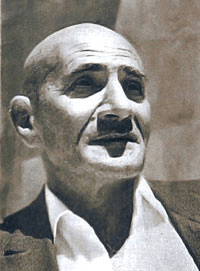Rafael Israelyan
| Rafael Israelyan | |
|---|---|
 | |
| Born |
September 17, 1908 Tiflis, Russian Empire |
| Died |
September 8, 1973 (aged 64) Yerevan, Soviet Armenia |
| Nationality | Armenian |
| Occupation | Architect |
Rafael Israelyan (Armenian: Ռաֆայել Իսրայելյան; September 17, 1908 – September 8, 1973) was an Armenian architect and designer. He is the author of an architectural heritage of civil buildings, monuments and design works.
Background and Education
Rafael Israelyan was born in 1908 in Tbilisi, Georgia. Between 1926-1928 he studied at the architectural faculty of the Academy of Arts in Tbilisi, and then at the architectural faculty of the Institute of Communal Construction of Leningrad named after Ilya Repin. He graduated in 1934 with the title of artist-architect. In 1936 he successfully completed his courses for the Masters degree at the same institute. In the same year he moved to Yerevan and started working in Yerevan city's architectural design institutions.
Israelyan had a long teaching career in Yerevan Polytechnic Institute between 1941 and 1963.[1] He was a member of the Architectural Commission of the Mother See of Holy Etchmiadzin between 1956 and 1970.
After the death of Rafayel Israelyan, his son Areg, also an architect, took the responsibility to complete his father's unfinished projects.
Works and projects
Israelyan designed massive constructions of natural stone, combining neo-classicism with Armenian architectural traditions. One of his early works was the building of an intricate complex of wine cellars in 1937 for the Ararat Trust of Yerevan, its concise volumes blending organically with the rocky landscape.
During and after World War II, continuing the Armenian custom of springs that commemorated the dead, he built monuments in numerous towns and villages. He also revived the ancient Armenian tradition of the Khachkars. Israelyan was author of more than 150 residential buildings, monuments and complexes in Armenia and other countries.
His most famous works are the followings:[2]
- Wine vaults of the Yerevan Ararat Wine Factory (1937–1961)
- Hrazdan Gorge Aqueduct (1949-1950)
- The Military Museum (Victory Monument Museum) in Yerevan (1950–1967)
- The statue of "Vahagn Choking the Dragons" (Yerevan-Sevan highway 1962)
- The Khachkar-Monument in the memory of the Armenian Genocide victims in Etchmiadzin Cathedral (1965)
- The Sardarapat Memorial of the 1918 Battle of Sardarapat (1968)
- The Haçin resistance memorial in the town of Nor Hachen (1973)
- The Mousa Ler battle memorial in the town of Musaler (1976)
- The reconstructed building of Saint Sargis Church, Yerevan (1976)
- The Ethnographic Museum in Sardarapat (1978)
- The Battle of Bash Abaran monument in Aparan (1979)
- St. Vartan Cathedral, New York, United States (1968)
- St. Forty Martyrs Armenian Church, Milano, Italy
- St. Nerses Shnorhali Armenian church of Montevideo, Uruguay

